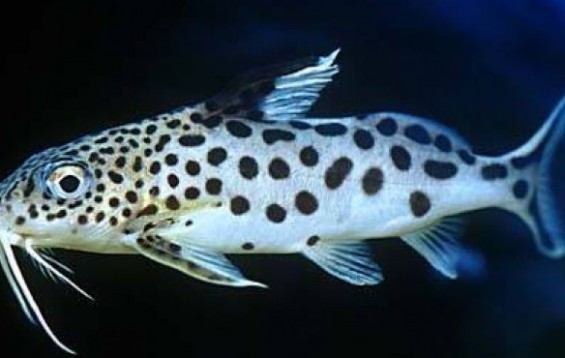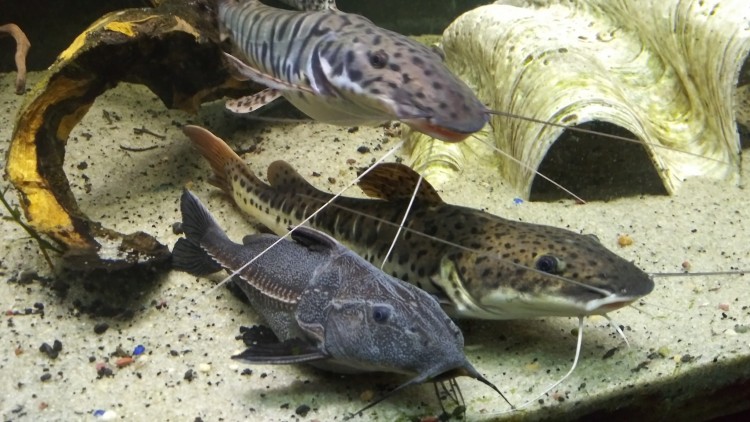- Name:
Pictus Catfish
(View AKA's) - Family: Pimelodidae
- Species: Catfish
- Scientific Name: Pimelodus pictus


More Details
General info about Pictus Catfish
The average adult is 4.8 inches and can live up to 8 years. This species prefers an aquarium with dim light, plenty of swimming place, a lot of hiding places and with a temperature of 72ºF – 78ºF. They need an aquarium with frequent and efficient maintenance since they are sensitive to deteriorating water conditions, bad water conditions may cause the individuals to lose their barbs.
It is a peaceful species but if any of its tankmates is a small sized species they may eat them, also, it is not a good idea to keep them with tankmates that may predate on them because Pimelodus pictus has pectoral and dorsal spines that can cause the death of the predator. As a shoaling species they should be kept in groups of at least 5, they can be kept alone but will not be happy and will remain hidden all the time. Two varieties exist, the Peruvian variety has spots all over its body with smaller spots around the head, the Colombian variety has more spots but these are smaller and less defined.
Pictus Catfish Diet & Nutrition
They are omnivorous. In the wild they feed mainly on invertebrates and small sizes fishes. In an aquarium they can be fed with dried foods but it is advisable to also feed them with live meaty food like bloodworms and small earthworms. They only need to be fed every few days, feeding them more often will cause them to have a distended stomach since they will eat until they can’t eat anymore. They are bottom dwellers and use their barbs to find sunken food, sometimes they will eat leftovers from their tankmates but they shouldn’t be seen as cleaners and they won’t survive just by eating leftovers.
Determining Sex of Pictus Catfish
There is no way to determine sex in this species.
Breeding & Spawning Pictus Catfish
There isn’t much information about their breeding season, except that it happens in the warm, rainy season and that there is no parental care.
Common Diseases with Pictus Catfish
Pimelodus pictus is a scaleless fish and so is extremely vulnerable to certain diseases like whitespot. Care must be taken because this species is also very sensitive to many of the medications on the market.
Pictus Catfish Origin
This species is native to Rio Orinocan and the Amazon basins in Colombia, Peru and Brazil. It inhabits shallow, flowing waters with sandy or muddy substrates.
Caution with Pictus Catfish
They have rigid pectoral and dorsal spines that can become tangled in an aquarium net so it is advisable to use plastic containers to move them. These spines can also cause a painful wound so it is best to avoid handling them.
It is important to have a sandy or rounded gravel substrate instead of a sharp gravel substrate to protect their barbs, it is also important to keep the substrate clean to prevent the barbs from getting infected.
Acclimating Pictus Catfish
They are nocturnal species so while there getting acclimatized to their new aquarium it is a good idea to feed them at night, which is when they are most active.
Relevent Articles
Original Detail
| Name | Species | Family | Scientific Name | More Detail | Added by |
|---|---|---|---|---|---|
| Pictus Catfish | Catfish | Pimelodidae | Pimelodus pictus | The average adult is 4.8 inches and can live up to 8 years. This species prefers an aquarium with dim light, plenty of swimming place, a lot of hiding places and with a temperature of 72ºF – 78ºF. They need an aquarium with frequent and efficient maintenance since they are sensitive to deteriorating water conditions, bad water conditions may cause the individuals to lose their barbs. It is a peaceful species but if any of its tankmates is a small sized species they may eat them, also, it is not a good idea to keep them with tankmates that may predate on them because Pimelodus pictus has pectoral and dorsal spines that can cause the death of the predator. As a shoaling species they should be kept in groups of at least 5, they can be kept alone but will not be happy and will remain hidden all the time. Two varieties exist, the Peruvian variety has spots all over its body with smaller spots around the head, the Colombian variety has more spots but these are smaller and less defined. | PalaciosAn |



